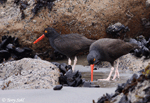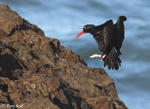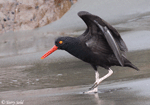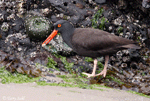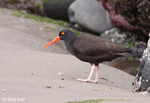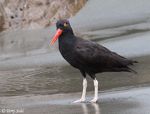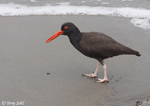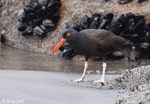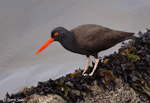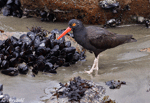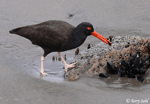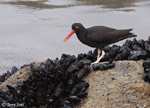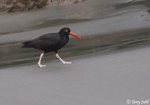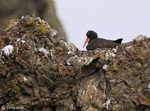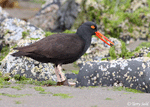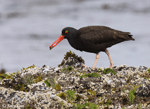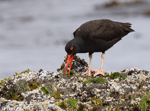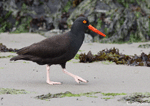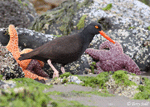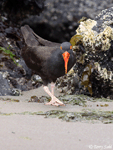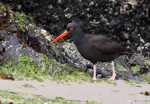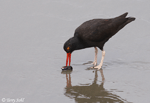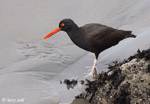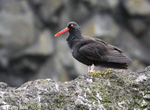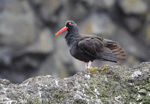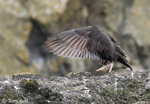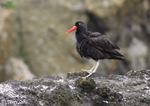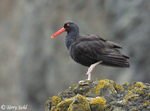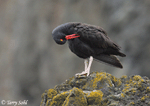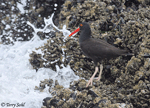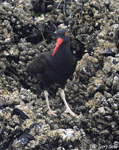| Length: 18 inches | Wingspan: 32 inches | Seasonality: Non-resident in South Dakota |
| ID Keys: Unmistakeable, with all black body, long sturyd orange bill, yellow eye with orange eye-ring, and pale legs | ||
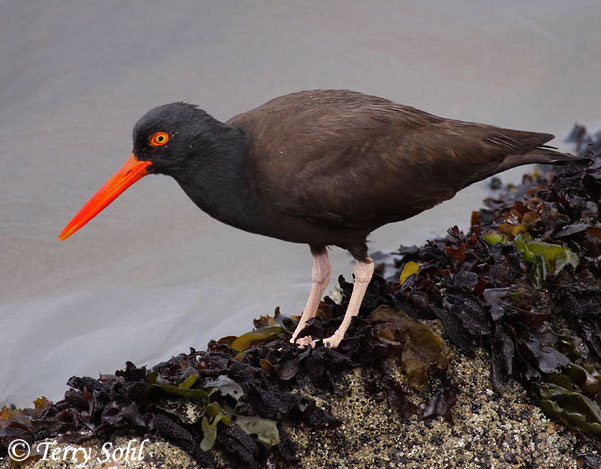 The
Black Oystercatcher is a distinctive bird of rocky coasts in western North
America. With their brilliantly orangish-red bill contrasting with
their black plumage and pale legs, they are an unmistakeable sight as they
forage along shorelines for shellfish and other prey. Pairs of Black
Oystercatchers typically mate for life, may live over 15 years, and rarely
wander far from their home range. Because of these characteristics,
birders often are able to observe the same mated pair for several years at a
time. .
The
Black Oystercatcher is a distinctive bird of rocky coasts in western North
America. With their brilliantly orangish-red bill contrasting with
their black plumage and pale legs, they are an unmistakeable sight as they
forage along shorelines for shellfish and other prey. Pairs of Black
Oystercatchers typically mate for life, may live over 15 years, and rarely
wander far from their home range. Because of these characteristics,
birders often are able to observe the same mated pair for several years at a
time. .
Habitat: At all seasons, Black Oystercatchers are found along rocky shorelines, strongly preferring offshore rocky islands and the nearby mainland shoreline. During winter months, they can also sometimes be found on mudflats or in other areas close to rocky shorelines.
Diet: Mostly feeds on shellfish such as limpets or mussels, but will also feed on a variety of other marine life, such as crabs, sea urchins, marine worms, and large insect larvae.
Behavior: Forages by walking along the rocky shoreline in search of shellfish. Most foraging is done at low tide, when mussel beds or other food sources are exposed.
Nesting: The Black Oystercatcher is thought to mate for life, with breeding pairs staying in the same general vicinity for most of their lives. The nest is on high ground, well above high-tide line, most often on an offshore island. Both the male and female will help to build the nest, which consists of a slight scrape on the ground, usually lined with a few shells or small rocks. Both parents incubate the eggs and help to raise the young..
Interactive eBird Map: Click to access an interactive eBird map of Black Oystercatcher sightings
Song: Black Oystercatchers make a variety of flight and alarm calls, most consisting of shrill ringing calls in series.
Migration: Black Osytercatchers are permanent residents in most of their range. Some populations may make short-distance migrations after breeding, but generally remain close to summer breeding grounds.
Similar Species: Distinctive, especially in range along the Pacific Coast. Similar in structure to the American Osytercatcher.
Conservation Status: The IUCN currently lists the Black Oystercatcher as a species of "Least Concern". Populations are still widespread, with Black Oystercatchers locally common in some locations.
Further Information: 1) Cornell's All About Birds - Black Oystercatcher
2) Pacific Wildlife Foundation - Black Oystercatcher
3) Audubon.org - Black Oystercatcher
Photo Information: June 10th, 2009 - Sutro Baths area of coastal San Francisco, California - Terry Sohl
| Click below for a higher-resolution map |
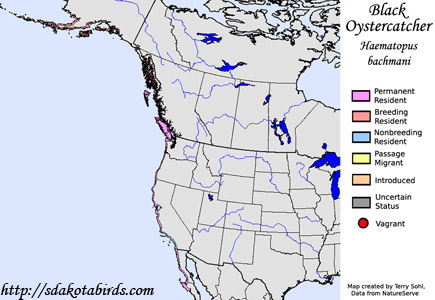 |
| South Dakota Status: Non-resident in South Dakota |
Additional Black Oystercatcher Photos
Click for a higher-resolution version of these photos
